Abstract
The objective of this study was to evaluate the effects of window films on indoor environmental conditions and electricity consumption of air conditioning. The research focused on the performance of different window films (HAG, RG), taking into account variations from different building orientations. The findings of this research indicated that building orientation could significantly influence the duration of direct sunlight entering the interior, with the areas closer to the glass being more susceptible to the effects of outdoor temperature and solar radiation. The clear glass with heat-absorbing film (HAG) and reflective film (RG) both reduced the indoor temperature and indoor illuminance while increasing indoor comfort. The RG could accumulate less heat on the glass surface compared with the HAG. The glass temperature of the RG will be lower than the HAG. The electricity-saving ratios of the HAG were 1.4%, 1.9%, 1.4%, and 1.2%, respectively, when facing the east, south, west, and northwest orientations compared with the clear glass (OG). The electricity-saving ratios of the RG were 3%, 4.2%, 4.2%, and 10.3%, respectively.
1. Introduction
The greenhouse gas emissions and global consumption of energy continue to increase, and energy conservation and emissions reduction have become common goals for governments and businesses worldwide. As a crucial area of energy consumption, the building industry’s application of energy-saving technologies is particularly critical. Among the important components of a building’s outer wall, glass windows have a significant impact on the building’s energy efficiency due to heat transfer through conduction. By improving the insulation performance of glass windows, the building’s energy consumption can be effectively reduced, indoor temperature can be lowered, and the comfort and livability of residential and office environments can be enhanced [1,2,3,4,5,6,7,8,9].
Insulation films are one of the key technologies of building energy conservation. When insulation films are installed on window glass, they can reflect a large amount of infrared radiation and reduce the absorption of solar heat radiation. Especially in tropical and subtropical regions, they can lower the indoor temperature caused by sunlight heating and reduce indoor discomfort and the air conditioning load, thereby lowering energy consumption.
Tsai [10] conducted actual thermal environment measurements in different seasons and performed numerical simulations of indoor environments using the EnergyPlus 8.7 software. The results showed that insulation film can effectively reduce indoor temperatures. Moreover, when the insulation film was exposed to higher outdoor temperatures in hot summers, the insulation performance of glass walls with insulation film was better. Insulation films with lower solar heat gain coefficients (SHGCs) also had better energy-saving and thermal-comfort-improving effects.
Yin et al. [11] studied the energy-saving effect of window insulation films on commercial buildings with curtain walls in Shanghai, China. The annual performance of a building with and without insulating window film was modeled using eQUEST. The results show that if the film is applied to the inside and outside of the existing windows, the shading coefficient and SHGC can be reduced by 44% and 22%, respectively. In addition, for a system with double-paned LOW-E glazing, applying film to the outside and inside of the window reduces the cooling load by 27.5% and 2.2%, respectively. The results show that adding window film to the inside of the window has no significant effect. This is because the increase in the amount of heat conducted by the window offsets the reduction in the cooling load due to solar radiation.
In Li et al. [12], the glass surface temperatures of several kinds of film were measured and compared with those of similar windows without film. EnergyPlus was also used to evaluate the energy-saving potential of the films applied to the glass of three different functional rooms in Hong Kong. The results indicated that the insulation performance of clear glass was better than that of laminated glass or tinted. Insulation film applied to all functional areas of a commercial building has good potential for energy savings, with the best results being achieved in offices.
Ismail et al. [13] studied the effects of conventional single-pane windows, ventilation windows with reflective film, and those without reflective film in hot climates. The results show that the temperature reduction increases as the gap between the glass sheets of the ventilator increases; the ventilator without reflective film shows a higher SHGC value and transfers 3.5 times more heat to the indoor environment than the ventilator with reflective film.
Nagahama et al. [14] examined the performance of Albeedo insulation film. It can selectively reflect near-infrared rays into the sky. It not only reduces the indoor cold load but also minimizes heat loss from surrounding buildings compared to reflective windows of solar radiation such as LOW-E glass and the general type of mirror reflective thermal barrier film applied to glass. The solar transmittance is approximately 50% lower than that of non-filmed glass. At an angle of incidence of 60°, the near-infrared upward reflectance of Albeedo film is approximately 33%. The properties of the glass and the results of field tests proved that the use of Albeedo insulated windows can decrease the indoor cooling load without damaging the external thermal environment.
Chaiyapinunt et al. [15] studied the thermal comfort and thermal conductivity of different types of glass and insulation films. The study found that when comparing glass with and without insulation film, the use of insulation film has a better effect on reducing heat transfer. In terms of thermal comfort indicators, the predicted percentage dissatisfied (PPD) was used. The overall PPD was divided into the PPD caused by the glass surface temperature and the PPD caused by solar radiation, and the results showed that for most glass windows except for reflective glass, the PPD value caused by solar radiation is much higher than the PPD value caused by the surface temperature effect.
Other scholars have conducted related studies on thermal comfort. Khamporn and Chaiyapinunt [16] studied the influence of glass windows on the thermal comfort of people sitting near them. The study found that the mean radiant temperature, PMV, and PPD are all dependent on the transmitted solar radiation and surface temperature of the glass window. The higher the mean radiant temperature, the higher the values of PMV and PPD, and the thermal discomfort in rooms with transparent glass windows mainly comes from solar radiation, with the level of discomfort varying directly with the amount of transmitted solar radiation. For highly transparent glass windows, the thermal discomfort caused by solar radiation is greater than that caused by surface temperature. In contrast, for low transmission rate (high absorption rate) glass windows, the thermal discomfort caused by the surface temperature becomes more important compared to the thermal discomfort caused by solar radiation.
Moretti and Belloni [17] conducted a comprehensive characterization of the thermal and lighting performance of solar control films using an experimental setup and numerical analysis. They studied two offices, one with solar control films and one without solar control films, in a multifunctional building located in a mild climate. The solar control film strongly reduced the incident solar radiation. In the spring season, the window film was able to lower the indoor air temperature by approximately 2 °C to 3 °C on sunny days. In addition, the contribution of artificial lighting increased, particularly on cloudy days, as the daily average illuminance level was reduced by approximately 59%.
The objective of this study is to use SPINLab [18,19] as an experimental platform to observe the thermal insulation performance of clear glass with windows films after changing some testing parameters. The parameter items include clear glass (OG), heat-absorbing film, reflective film, and building orientation (east, south, west, and northwest). The study also investigates the impact of different glass performances on air conditioning electricity consumption, the light environment, and thermal comfort. These research efforts aim to reduce building energy consumption, improve indoor environments, and enhance the comfort and livability of residential and office spaces.
2. Experimental Equipment and Method
The exterior of SPINLab with glass curtain is shown in Figure 1a. A monitoring and control room is in the back while two test rooms with glass curtain openings are in the front. Test rooms are set with identical office configurations for comparison. Figure 1b shows the interior of one test room. The inner dimensions of a test room are 6.5 m × 4.8 m × 3.8 m. Each test room is equipped with one split-type air conditioner (AC) of (HITACHI RAD-140NX1) [19,20].
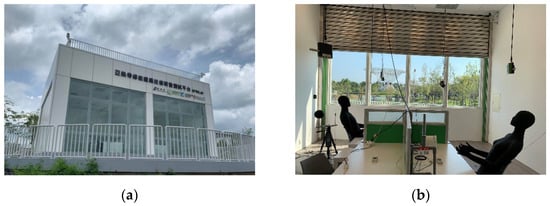
Figure 1.
Appearance of SPINLab (a) and indoor layout of Room A (b).
Figure 2 shows the indoor layout. Four office table-and-chair sets are numbered 1–4 with dividing partitions in each room to simulate office scenarios. The window-to-wall ratio on the glass curtain wall is set to 40% by adjusting the rolling shutter. Therefore, only 40% (in height) of the glass allows incident sunlight. A temperature and humidity sensor for outdoor temperature is located on the roof. Both Room A and Room B have 4 temperature and humidity sensors, which are located at seats 1–4, as shown in Figure 2 and Table 1. The temperature and humidity sensors are suspended 1.6 m above the ground. The human heat dissipation heat load data indoors was referred to in several references [18,19,20,21,22]. This study simulated that two people are using two computers in each room. Two heaters were set for computers and another two heaters for dummies. The total heat generation was 1 kW for room. The inlets and outlets of AC are located near the window and in the middle of room, respectively. The sensors of AC are at the back of each room and away from the windows.
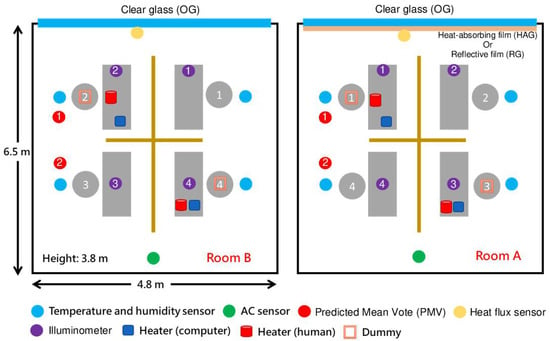
Figure 2.
Experimental setup of Room A and Room B.

Table 1.
Measurement sensors.
This study conducted experiments using SPINLab to investigate the key factors affecting building electricity consumption, light environment, and thermal comfort. The parameter items included clear glass (OG), heat-absorbing film, reflective film, and building orientation (east, south, west, and northwest). The indoor office environment was used to investigate the following: (1) clear glass (Room B) vs clear glass with heat-absorbing film (HAG) (Room A), (2) clear glass (Room B) vs clear glass with reflective film (RG) (Room A). The clear glass (OG) is a laminated glass which has a nominal thickness of 12 + 12 mm. The optical properties of OG, HAG, and RG are shown in Table 2. Compared with clear glass (OG), it was observed that when the heat-absorbing film was applied to clear glass (HAG), the visible light transmittance decreased from 85.82% to 62.94%, the visible light reflectance decreased from 7.44% to 6.92%, the solar heat gain coefficient (SHGC) decreased from 0.7386 to 0.4517, and the shading coefficient decreased from 0.8490 to 0.5192. This indicated that clear glass with the heat-absorbing film could reduce the visible light transmittance and block heat from entering into the building.

Table 2.
The optical properties of OG, HAG and RG.
As for the clear glass with the reflective film (RG), the visible light transmittance decreased from 85.82% to 62.03%, the visible light reflectance increased from 7.44% to 12.65%, SHGC decreased from 0.7386 to 0.4365, and the shading coefficient decreased from 0.8490 to 0.5018. This indicated that clear glass with the reflective film not only reduced the visible light transmittance but also reflected part of visible light and blocked more heat from entering into the building.
3. Results and Discussion
3.1. Heat-Absorbing Film
Figure 3 shows the comparison of temperature between Room A—clear glass with heat-absorbing film (HAG)—and Room B—clear glass (OG) when the AC was activated. In Figure 3, A12 represents the average temperature at points 1 and 2 in Room A, which were closer to the glass; A34 is the average temperature at points 3 and 4, as shown in Figure 2. AG is the temperature of HAG, and line AC is the temperature from the sensor of the AC. B12, B34 and BG are the values from Room B. BG is the surface temperature of OG.
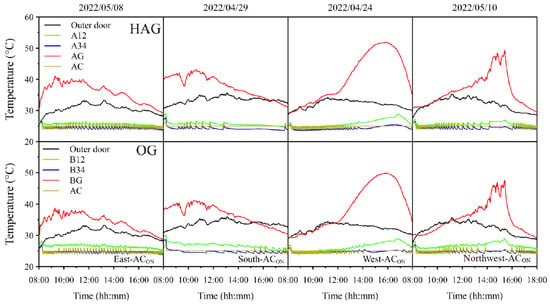
Figure 3.
Variations of temperature for the heat-absorbing film.
While facing east, the temperatures of AG and BG were significantly higher than the outdoor temperature before noon due to direct sunlight. After 12:00, there is no direct sunlight, and the temperatures of AG and BG will decrease with time. At 18:00, the temperatures of AG and BG will be close to the outdoor temperature. However, the temperature of AG will be slightly higher than that of BG.
While facing south, the temperatures of AG and BG were significantly higher than the outdoor temperature before noon due to direct sunlight. After 12:00, there is no direct sunlight, and the temperatures of AG and BG will decrease with time. The temperature of BG will be lower than the outdoor temperature after 15:00, while the temperature of AG will be lower than the outdoor temperature after 16:00.
While facing west, the temperatures of AG and BG were similar to the outdoor temperature before noon, but the temperature of AG was slightly higher than the outdoor temperature. After 12:00, the AG and BG glass temperatures will increase with time due to direct sunlight and will be higher than the outdoor temperature.
While facing northwest, the temperatures of AG and BG will increase with time and be higher than the outdoor temperature after 11:00. After 16:00, the temperatures of AG and BG will decrease with time. At 18:00, the temperatures of AG and BG glass will be close to the outdoor temperature. However, the temperature of AG will be slightly higher than that of BG.
Generally, the indoor temperature was controlled by the AC to remain at 26 °C. Both A12 and B12 were higher than A34 and B34, respectively, due to the influence of exposure to sunlight. The effect of direct sunlight is most obvious before noon while facing east and south and in afternoon while facing west and northwest. As a result, A12 and B12 reached over 28 °C at 17:00 while facing west. In comparison of the temperatures in rooms A and B, the indoor temperature in Room A was slightly lower, but the glass temperature was slightly higher in Room A. The heat-absorbing film blocked the heat radiation from entering the room, thereby reducing the indoor temperature. However, it also accumulated heat on the glass surface while blocking the heat radiation from the surface, causing the glass temperature to increase.
Figure 4 shows the comparison of heat flux, PMV, and illuminance between Room A—clear glass with heat-absorbing film (HAG)—and Room B—clear glass (OG) when the AC was activated. A1 and A2 and B1 and B2 represent the measurements at points 1 and 2 in Room A (HAG) and Room B (OG), respectively. From the comparison of heat flux, it was observed that the heat flux in Room A was significantly higher. The heat-absorbing film accumulated heat on the glass surface and obstructed the release of heat from the glass, resulting in an increase in the heat flux on the glass.
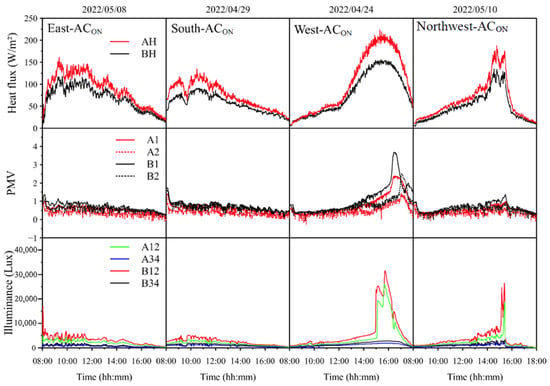
Figure 4.
Variations of data for the heat-absorbing film.
Regarding the variation process of heat flux at building orientations of east and south: between 8:00 a.m. and 12:00 p.m., AH and BH increase with time due to the influence of sunlight; after 12:00 p.m., the effect of sunlight decreases, and the temperatures of AH and BH decrease with time.
The variation processes of heat flux at the building orientation of west before 12:00 are similar for AH and BH. After 12:00, both AH and BH increase with time due to the direct sunlight, with AH being significantly higher than BH. After 16:00, the influence of sunlight decreases, and both AH and BH decrease with time.
The variation process of heat flux of AH is higher than that of BH in the northwest direction. After 13:00, both AH and BH increase with time due to the direct sunlight, with AH being significantly higher than BH. After 16:00, the influence of sunlight decreases due to cloudy weather, and both AH and BH decrease with time.
From the comparison of PMV, it was found that A1 and B1, which were closer to the glass, were more significantly affected by sunlight and outdoor temperature, resulting in higher PMV values than those of A2 and B2. The airflow from the AC affected the PMV and caused the indoor temperature to decrease. The PMV value fluctuated between 0 and 1, mainly due to the variation in wind speed by AC. Only when the solar radiation was stronger on the West or Northwest orientation, there was a significant increase in PMV, and the value in room A was lower than that of in room B. The heat-absorbing film (HAG) reduced heat radiation inside the room, resulting in a lower indoor temperature, and the indoor comfort was improved.
From the comparison of illuminance, it was observed that A12 and B12, which were closer to the glass, were significantly affected by sunlight, resulting in the higher illuminance than that of A34 and B34. Additionally, the illuminance in Room A was lower than that of in Room B. The heat-absorbing film reduced the transmittance of visible light, causing a decrease in the indoor illuminance. While facing west and northwest, the illuminance of A12 and B12 increased rapidly due to incident of direct sunlight in the afternoon.
3.2. Reflective Film
Figure 5 shows the comparison of temperature between Room A—clear glass with reflective film (RG)—and Room B—clear glass (OG) when the AC was activated. The AC was set to 26 °C. Generally, the indoor temperature was controlled by the AC to remain at 26 °C. Similar to the results from the heat-absorbing film, A12 and B12 were also higher than A34 and B34, respectively, while having different building orientations. The effect of direct sunlight is most obvious before noon while facing east and south and in afternoon while facing west and northwest. The temperature drop of AG and BG can be observed after 15:00 to 16:30 while facing west. It was due to the cloudy weather and sunlight that was temporary blocked.
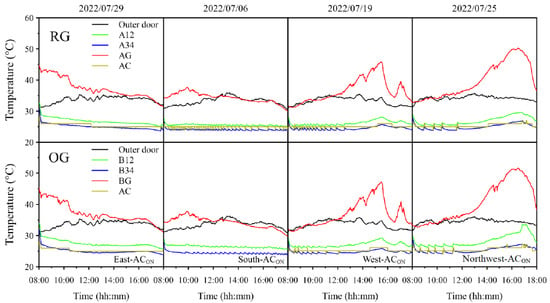
Figure 5.
Variations in temperature for the reflective film.
In a comparison of the temperature in rooms A and B, both the indoor temperature and glass temperature in Room A were slightly lower than those in Room B. The reflective film was capable of reflecting heat radiation and reducing the heat transfer into glass, resulting in a decrease in indoor temperature and glass temperature.
Figure 6 shows the comparison of the heat flux, PMV, and illuminance between Room A—clear glass with reflective film (RG)—and Room B—clear glass (OG) when the AC was activated. From the comparison of heat flux, it was observed that the heat flux in Room A was only slightly higher than that in Room B. The reflective film could reflect heat radiation; it also accumulated some heat on the glass surface and blocked the release of heat, causing an increase in heat flux.
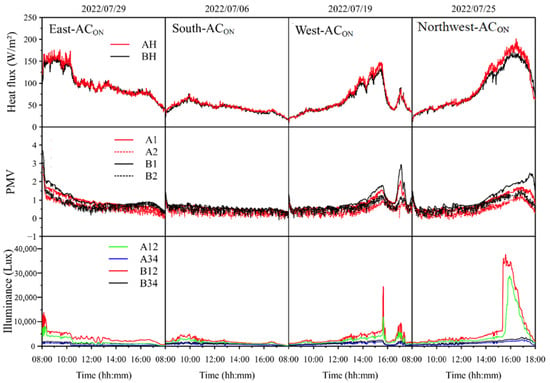
Figure 6.
Variations in data for the reflective film.
From the comparison of PMV, it was found that A1 and B1, which were closer to the glass, were more affected by sunlight and outdoor temperature, resulting in the higher PMV values than those of A2 and B2. The airflow from the AC also affected the PMV and caused fluctuations in the value between 0 and 1, with more significant changes occurring only when solar radiation was strong. Moreover, the PMV value of Room A was slightly lower, which shows that the reflective film can reduce indoor heat radiation, thereby lowering the indoor temperature and improving the indoor comfort.
From the comparison of illuminance, it was observed that A12 and B12, which were closer to the glass, were more significantly affected by sunlight, resulting in the higher illuminance than those of A34 and B34. The illuminance in Room A was lower than that in Room B, which shows that the reflective film also reduced the transmittance of visible light and caused a decrease in the indoor illuminance. While facing west, the cloudy weather caused the illuminance to drop suddenly from 16:00 to 17:00. In contrast, a sudden increase in illuminance of A12 and B12 can be observed while facing northwest.
3.3. Comparison of Heat-Absorbing Film (HAG) and Reflective Film (RG)
Figure 7 compares the temperature between the clear glass with heat-absorbing film and the clear glass with reflective film when the AC was activated. In the heat-absorbing film experiment (HAG), the temperature difference between the indoor temperatures of rooms A and B (B12-A12, B34-A34) ranged from approximately −0.8 °C to 2.15 °C, and the temperature difference of the glass (AG-BG) ranged from approximately −0.25 °C to 3.75 °C. In the reflective film experiment (RG), the temperature difference between the indoor temperatures of rooms A and B ranged from approximately −0.95 °C to 4.5 °C, and the temperature difference of the glass ranged from approximately −4.1 °C to 0.95 °C.
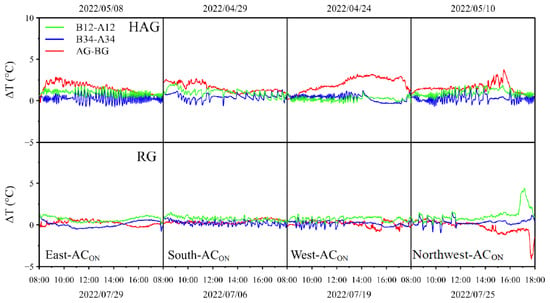
Figure 7.
The variation process of temperature difference of the HAG or RG with different building orientations.
By comparing the glass temperature, the glass temperature of the heat-absorbing film (HAG) was found to be higher than that of the clear glass (OG), while the glass temperature of the reflective film (RG) was found to be lower than that of the clear glass (OG). When compared to the reflective film (RG), the heat-absorbing film (HAG) accumulated more heat on the glass surface and blocked the heat release from the glass surface, causing an increase in the glass temperature. As for the indoor temperature, it was observed that except in the morning while facing northwest, B12-A12 of the heat-absorbing film was lower than B34-A34. While at other times, B12-A12 was higher than B34-A34. In contrast, it could be stated that the reflective film (RG) consistently showed B12-A12 higher than B34-A34. This vividly indicated that both types of insulation films could lower the indoor temperature. However, the effect of insulation was only significant in the areas closer to the glass which were affected by sunlight directly during certain time periods.
Figure 8 compares the heat flux between the clear glass with heat-absorbing film (HAG) and the clear glass with reflective film (RG) when the AC was activated. It was observed that the heat flux in Room A was higher for both types of insulation films, but this phenomenon was more pronounced with the heat-absorbing film. The increase of heat flux on the glass surface was found to be in proportion to the base heat flux without insulation.
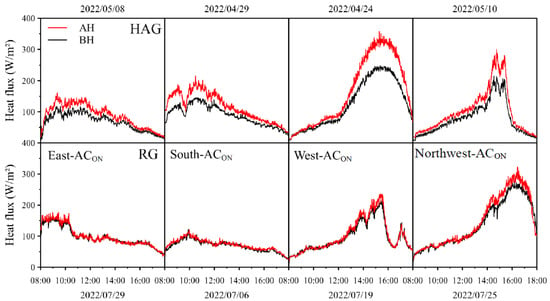
Figure 8.
Variations of heat flux for the heat-absorbing film (HAG) and reflective film (RG).
Figure 9 compares the PMV between the clear glass with heat-absorbing film (HAG) and the clear glass with reflective film (RG). For the heat-absorbing film, the PMV difference between B1 and A1 ranged from −0.38 to 1.42, while that between B2 and A2 ranged from −0.37 to 1.24. For the reflective film, the PMV difference between B1 and A1 ranged from −0.37 to 1.3, while that between B2 and A2 ranged from −0.44 to 1.06. This indicated that both types of insulation films could effectively reduce the PMV value and achieve better indoor comfort. The reflective film performed slightly better than the heat-absorbing film.
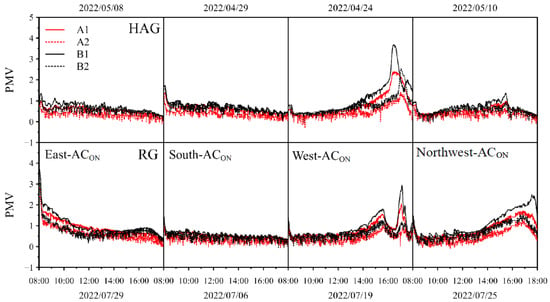
Figure 9.
Variations of PMV for the heat-absorbing film and reflective film (on).
Figure 10 compares the illuminance between the clear glass with heat-absorbing film (HAG) and clear glass with reflective film (RG). A12 and B12, which were closer to the glass, were more affected by sunlight and had higher variation in illuminance than A34 and B34. Both types of insulation films reduced the transmittance of visible light and caused a decrease in the indoor illuminance.
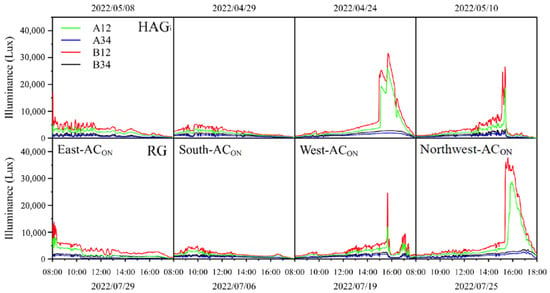
Figure 10.
Variations of illuminance for the heat-absorbing film and reflective film.
Figure 11 compares the electricity consumption between the clear glass with heat-absorbing film (HAG) and clear glass with reflective film (RG) when the AC was activated. The results indicated that the heat-absorbing film saved 1.4%, 1.9%, 1.4%, and 1.2% of the electricity consumption, respectively, when facing east, south, west, and northwest. In contrast, the reflective film saved 3%, 4.2%, 4.2%, and 10.3% of the electricity consumption, respectively. The comparison result showed that both types of insulation films could reduce AC electricity consumption. Additionally, due to the different insulation mechanisms and the influence of seasons, the reflective film had the better electricity-saving effect. The experiments on the heat-absorbing film and the reflective film were conducted in spring and summer, respectively. The studies indicated that the hotter the climate, the electricity-saving effect would be more significant. Therefore, it was observed that except for the south orientation, the electricity consumption of the reflective film was higher than that of the heat-absorbing film in other orientations, especially when facing northwest with hot weather, resulting in the more significant electricity-saving effect.
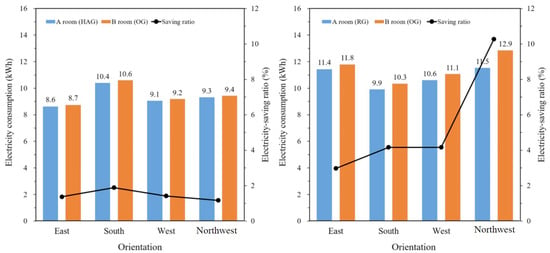
Figure 11.
Variations of electricity consumption for the heat-absorbing film (HAG) and reflective film (RG).
In the future, scholars can further explore the effect of seasonal changes (autumn, winter, or plum rain), direct sunlight, or night on indoor thermal comfort and air-conditioning power consumption with different building orientations.
4. Conclusions
This study conducted experiments using SPINLab to investigate the key factors affecting building electricity consumption, the light environment, and thermal comfort. The parameter items included OG, HAG, RG, and building orientation. The conclusions are as follows:
- (1)
- The orientation of a building could affect the duration of direct sunlight penetration into indoor spaces, with the areas closer to the windows being more susceptible to the influence of solar radiation and outdoor temperature. The HAG and RG can reduce the PMV value in indoor spaces compared with the OG. The reflective film performed slightly better than the heat-absorbing film. Both types of insulation films (HAG or RG) reduced the transmittance of visible light and caused a decrease in indoor illuminance.
- (2)
- The clear glass with heat-absorbing film (HAG) and reflective film (RG) both can reduce the indoor temperature and indoor illuminance while increasing indoor comfort. The HAG accumulated the heat on the glass surface, simultaneously inhibiting the release of heat from the glass surface, resulting in an increased glass temperature and heat flux. The RG accumulated less heat on the glass surface compared with HAG. Therefore, the glass temperature of the RG was lower than that of the HAG.
- (3)
- Both the HAG and RG could effectively reduce the electricity consumption of air conditioning. The electricity-saving ratios of the HAG were 1.4%, 1.9%, 1.4%, and 1.2%, respectively, when the opening was facing the east, south, west, and northwest, while the electricity-saving ratios of the RG were 3%, 4.2%, 4.2%, and 10.3%, respectively. The electricity-saving effect of the RG was superior to that of the HAG. The studies indicated that the hotter the climate, the electricity-saving effect would be more significant.
Author Contributions
Writing—original draft preparation, H.-Y.H.; writing—review and editing, C.-K.C.; formal analysis, W.-C.H.; methodology and resources, F.-Y.L., C.-C.C. and T.-C.S.; project administration, P.-Y.Y.; supervision, T.-H.L. All authors have read and agreed to the published version of the manuscript.
Funding
The authors sincerely thank the Bureau of Energy, Ministry of Economic Affairs, Taiwan R.O.C., for the financial support while conducting research under the Energy Conservation System Technologies Demonstration and Application for Residential and Service Sectors Project (3/3).
Data Availability Statement
Not applicable.
Conflicts of Interest
The authors declare that there are no conflicts of interest.
References
- Sedaghat, A.; Sabati, M.; Alkhatib, F.; Oloomi, S.A.A.; Sabri, F.; Salem, H.; Zafar, W.J.; Malayer, M.A. Climate change and thermo-solar patterns of office buildings with/without window films in extreme hot-arid climate of Kuwait. Sol. Energy 2021, 217, 354–374. [Google Scholar] [CrossRef]
- Pereira, J.; Rivero, C.C.; Gomes, M.G.; Rodrigues, A.M.; Marrero, M. Energy, environmental and economic analysis of windows’ retrofit with solar control films: A case study in Mediterranean climate. Energy 2021, 233, 121083. [Google Scholar] [CrossRef]
- Cook, M.J.; Al-Hallaj, S. Film-based optical elements for passive solar concentration in a BIPV window application. Sol. Energy 2019, 180, 226–242. [Google Scholar] [CrossRef]
- Park, K.; Jin, S.; Kim, G. Transparent window film with embedded nano-shades for thermoregulation. Constr. Build. Mater. 2021, 269, 121280. [Google Scholar] [CrossRef]
- Lago, T.G.S.; Ismail, K.A.R.; Lino, F.A.M. Ventilated double glass window with reflective film: Modeling and assessment of performance. Sol. Energy 2019, 185, 72–88. [Google Scholar] [CrossRef]
- Hwang, R.; Shu, S. Building envelope regulations on thermal comfort in glass facade buildings and energy-saving potential for PMV-based comfort control. Build. Environ. 2011, 46, 824–834. [Google Scholar] [CrossRef]
- An, Y.; Choi, H.; Kim, E.; Kang, K.; Kim, S.; Kim, T. Empirical analysis of the effects of window remodeling using the slim double-skin window on the thermal performance of old buildings. Energy Build. 2022, 277, 112581. [Google Scholar] [CrossRef]
- Mobarak, B.; Komarizadehas, S.; Pascual, F.J.C.; Lozano-Galant, J.A. Application of Low-Cost Sensors for Accurate Ambient Temperature Monitoring. Buildings 2022, 12, 1411. [Google Scholar] [CrossRef]
- He, Z.; Yu, P.; Zeng, J.; Wen, L.; Ma, Y.; Ge, Y.; Zhang, H.; Miao, Z. A temperature and electric field responsive flexible hybrid composite film containing CsxWO3nanocrystals for energy efficient smart window. Sol. Energy 2023, 265, 112051. [Google Scholar] [CrossRef]
- Tsai, H. A Study of a Full-Scale Experimental House Applied in Exploring the Energy Conservation and Thermal Comfort Performance of Glass Heat-Insulating Film in Buildings. Master’s Thesis, Department of Bioenvironmental Systems Engineering, National Taiwan University, Taipei, Taiwan, 2018. [Google Scholar]
- Yin, R.; Xu, P.; Shen, P. Case study: Energy savings from solar window film in two commercial buildings in Shanghai. Energy Build. 2012, 45, 132–140. [Google Scholar] [CrossRef]
- Li, C.; Tan, J.; Chow, T.; Qiu, Z. Experimental and theoretical study on the effect of window films on building energy consumption. Energy Build. 2015, 102, 129–138. [Google Scholar] [CrossRef]
- Ismail, K.A.R.; Lago, T.G.S.; Lino, F.A.M.; Mondlane, M.V.; Teles, M.P.R. Experimental investigation on ventilated window with reflective film and development of correlations. Sol. Energy 2021, 230, 421–434. [Google Scholar] [CrossRef]
- Nagahama, T.; Sato, T.; Harima, T.; Shimizu, J. Optical properties and field test results of spectrally-selective solar control window film that enables not increasing downward reflection. Energy Build. 2017, 157, 176–183. [Google Scholar] [CrossRef]
- Chaiyapinunt, S.; Phueakphongsuriya, B.; Mongkornsaksit, K.; Khomporn, N. Performance rating of glass windows and glass windows with films in aspect of thermal comfort and heat transmission. Energy Build. 2005, 37, 725–738. [Google Scholar] [CrossRef]
- Khamporn, N.; Chaiyapinunt, S. An investigation on the human thermal comfort from a glass window. Eng. J. 2014, 18, 25–44. [Google Scholar] [CrossRef]
- Moretti, E.; Belloni, E. Evaluation of energy, thermal, and daylighting performance of solar control films for a case study in moderate climate. Build. Environ. 2015, 94, 183–195. [Google Scholar] [CrossRef]
- Hu, T.Y.; Chen, C.K.; Hu, W.C.; Lin, T.H.; Lin, F.Y.; Cheng, C.C.; Su, T.C.; Yu, P.Y. A Study on control strategy for air conditioning of western exposed rooms in subtropical region. Energies 2022, 15, 731. [Google Scholar] [CrossRef]
- Hu, T.Y.; Chen, C.K.; Lin, F.Y.; Lin, T.H. Influence of Roller Blinds Shading Strategy on West and South Facing. Energies 2023, 16, 711. [Google Scholar] [CrossRef]
- Meade, R.D.; Notley, S.R.; Kenny, G.P. Aging and human heat dissipation during exercise-heat stress: An update and future directions. Curr. Opin. Physiol. 2019, 10, 219–225. [Google Scholar] [CrossRef]
- Liang, C.; Li, X.; Shao, X.; Li, B. Direct relationship between the system cooling load and indoor heat gain in a non-uniform indoor environment. Energy 2020, 191, 116490. [Google Scholar] [CrossRef]
- de Rivera, P.J.R.; de Rivera, M.R.; Socorro, F.; de Rivera, M.R. Method for transient heat flux determination in human body surface using a direct calorimetry sensor. Measurement 2019, 139, 1–9. [Google Scholar] [CrossRef]
Disclaimer/Publisher’s Note: The statements, opinions and data contained in all publications are solely those of the individual author(s) and contributor(s) and not of MDPI and/or the editor(s). MDPI and/or the editor(s) disclaim responsibility for any injury to people or property resulting from any ideas, methods, instructions or products referred to in the content. |
© 2024 by the authors. Licensee MDPI, Basel, Switzerland. This article is an open access article distributed under the terms and conditions of the Creative Commons Attribution (CC BY) license (https://creativecommons.org/licenses/by/4.0/).